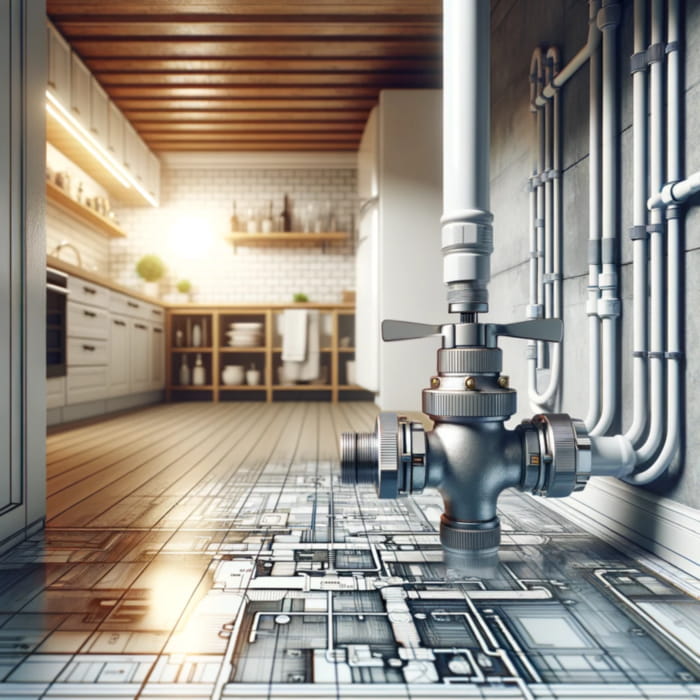Understanding how to find, turn, and use your home’s internal stopcock, stop valve, or stop tap is essential for every homeowner or resident. This article delves into the importance of knowing how to control your water supply in emergencies like leaks or burst pipes. We will guide you through locating and operating these critical valves, ensuring you’re prepared for any water-related issue.
Understanding the Importance of the Stopcock
The stopcock is your home’s first line of defense against water-related disasters. It acts as a crucial safety device, enabling you to isolate the water supply and prevent further damage until a professional plumber can address the issue. By shutting off the water, you can prevent:
- Flood Damage: A burst pipe or a faulty faucet can unleash a torrent of water, causing significant damage to your home’s interior. The stopcock allows you to halt the flow of water before it wreaks havoc.
- Water Waste: If a leak goes unnoticed, it can waste a significant amount of water, not only increasing your water bill but also contributing to environmental concerns. The stopcock helps you identify and address leaks promptly.
Locating Your Internal Stopcock: A Practical Guide
Knowing the location of your internal stopcock is essential for quick action in case of an emergency. Generally, the internal stopcock is situated near the point where the water line enters your home, typically near the meter or at the boundary between your property and the street.
Step-by-Step Guide to Turning Your Stopcock
- Identify the stopcock: Familiarize yourself with its appearance, which varies depending on the type of stopcock. Common types include ball valves, gate valves, and butterfly valves.
- Access the stopcock: Locate the stopcock near the water meter or at the boundary of your property. You may need to remove some debris or vegetation to reach it.
- Turn the stopcock: Locate the handle or lever on the stopcock. Turn it clockwise to shut off the water supply.
Stop Valve vs. Stop Tap: Understanding the Differences
The terms “stop valve” and “stop tap” are often used interchangeably, but there is a subtle distinction. A stop valve is a more precise and controlled valve, typically used for regulating water flow in specific areas of a plumbing system. A stop tap, on the other hand, is a more general term for a valve that can be used to isolate the water supply to an entire home or building.
The Stopcock’s Role in Emergency Management
In the event of a plumbing emergency, the stopcock is your tool to prevent further damage and allow you to call a plumber with confidence. By isolating the water supply, you can avoid the risk of flooding or wasting water while a professional addresses the root cause of the issue.
Regular Maintenance for Your Stopcock’s Longevity
Just like any other component in your home, the stopcock requires regular maintenance to ensure its optimal performance. Proper lubrication and inspection can help prevent leaks and keep the stopcock functioning smoothly over time.
When to Call a Plumber
While you can handle basic stopcock operation, there are instances when you should seek professional help:
- If the stopcock is difficult to turn or appears damaged.
- If you are unable to stop a leak or water flow despite turning off the stopcock.
- If you suspect a more complex plumbing issue, such as a broken pipe.
Educating Your Family About the Stopcock
Ensuring that everyone in your household knows about the stopcock’s location and how to operate it is crucial for safety and preparedness. Teaching children about the stopcock can help prevent accidental water damage and empower them to take action in an emergency.
Common Problems and Solutions
While stopcocks are generally reliable, they may encounter issues from time to time. Here are some common problems and their solutions:
- Sticky or hard-to-turn stopcock: Lubricate the threads of the stopcock with a silicone-based lubricant.
- Leaking stopcock: If the leak is minor, tighten the packing nut on the valve stem. If the leak persists, call a plumber.
Preparing for the Unexpected: Stopcock Knowledge as Essential Home Care
By understanding the stopcock’s purpose, location, and operation, you can take control of water-related emergencies and protect your home from potential damage. Regular maintenance, combined with family education, can further enhance your home’s preparedness and ensure that your stopcock remains a reliable safety net in times of need.
Should you turn stopcock on and off?
Turning the stopcock on and off is typically required when you’re conducting plumbing repairs or maintenance. It’s a valve for controlling the flow of water in a pipe, and turning it off can prevent water damage during repairs. However, frequent unnecessary operations can wear the valve out, leading to potential leaks.
How do you increase the water pressure on a stopcock?
To increase the water pressure on a stopcock, you first need to locate it. Once found, turn the valve in a clockwise direction which will tighten it and thereby increase the pressure. Be careful to not over-tighten as it can cause damage to the stopcock and associated pipework.
Key Points to Remember
- Locate Your Stopcock: Know where it is in your home.
- Turning the Stopcock: Learn the correct method to avoid damage.
- Maintenance: Regular checks ensure it works when needed.
- Emergency Use: Quick action can prevent major water damage.
- Professional Help: Know when to call a plumber for stopcock issues.
By the end of this article, you’ll be equipped with the knowledge and skills to confidently locate, use, and maintain your internal stopcock, ensuring you’re prepared for any water-related emergency in your home.


